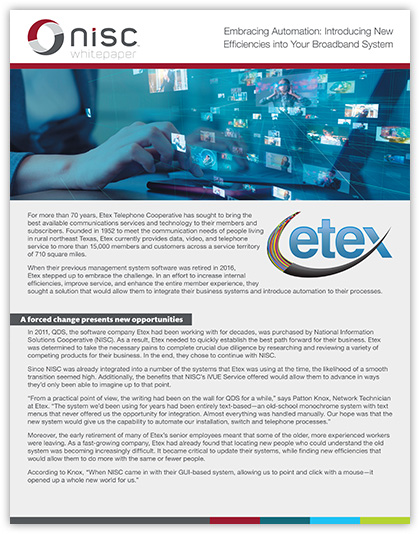For more than 70 years, Etex Telephone Cooperative has sought to bring the best available communications services and technology to their members and subscribers. Founded in 1952 to meet the communication needs of people living in rural northeast Texas, Etex currently provides data, video, and telephone service to more than 15,000 members and customers across a service territory of 710 square miles.
When their previous management system software was retired in 2016, Etex stepped up to embrace the challenge. In an effort to increase internal efficiencies, improve service, and enhance the entire member experience, they sought a solution that would allow them to integrate their business systems and introduce automation to their processes.
 |
| Click here to download |
A forced change presents new opportunities
In 2011, QDS, the software company Etex had been working with for decades, was purchased by National Information Solutions Cooperative (NISC). As a result, Etex needed to quickly establish the best path forward for their business. Etex was determined to take the necessary pains to complete crucial due diligence by researching and reviewing a variety of competing products for their business. In the end, they chose to continue with NISC.
Since NISC was already integrated into a number of the systems that Etex was using at the time, the likelihood of a smooth transition seemed high. Additionally, the benefits that NISC’s iVUE Service offered would allow them to advance in ways they’d only been able to imagine up to that point.
“From a practical point of view, the writing had been on the wall for QDS for a while,” says Patton Knox, Network Technician at Etex. “The system we’d been using for years had been entirely text-based—an old-school monochrome system with text menus that never offered us the opportunity for integration. Almost everything was handled manually. Our hope was that the new system would give us the capability to automate our installation, switch and telephone processes.”
Moreover, the early retirement of many of Etex’s senior employees meant that some of the older, more experienced workers were leaving. As a fast-growing company, Etex had already found that locating new people who could understand the old system was becoming increasingly difficult. It became critical to update their systems, while finding new efficiencies that would allow them to do more with the same or fewer people.
According to Knox, “When NISC came in with their GUI-based system, allowing us to point and click with a mouse—it opened up a whole new world for us.”
Putting NISC’s iVUE Service Solution and iVUE AppSuite to work
At its core, NISC’s iVUE Service offers a comprehensive billing platform for telecommunication services, designed to put an accurate and reliable bill in the customer’s hands each month. Central to the system is data integrity—keeping billing and inventory data accurate from all perspectives. In addition to the billing system, iVUE Service also provides services management, key account management, provisioning, and much more.
The iVUE AppSuite delivers extended practical functionality by allowing field technicians to have a mobile device that functions as an app version of iVUE Service. They can add equipment, remove equipment, and add billing codes to make updates to the billing record. The provisioning solution can be invoked through either iVUE Service or AppSuite depending upon user and situational preferences.
While AppSuite has proven to be one of the largest benefits for Etex of the iVUE Service, the overall service is capable of doing even more, such as billing, plant records, mapping, accounting (for time coding and payroll), and providing important analytics to help with marketing decisions.
Implementing the solution
Once Etex decided to move forward with NISC, things started to move quickly—data needed to be reviewed, scrubbed, and transitioned to the new system. Because every company implements vendor data differently, the ways in which Etex had historically collected and stored their data proved incompatible with iVUE Service. NISC came in and helped clean it up, making it easier to integrate into their system.
Soon after, the NISC team descended on the Etex site in Texas to set up labs for training—working with the staff, individually and in a classroom environment, to bring them up to speed. According to Daniel Holland, the Team Lead for NISC Professional Services, “It’s very common for us to come onsite as part of the Enterprise Live major training event to train the staff on all the major modules they’ll be implementing. It’s a critical piece of bringing the system online.”
“They really wowed us when it came to training,” agrees Knox. “A full team from NISC came down to Texas for multiple weeks of training and in-person classes.”
Countering resistance from within
Internally, there were challenges to be addressed as several key stakeholders proved resistant to the idea of automation implementation, requiring internal company PR to bring everyone on board.
“Resistance came from the fact that it takes work to automate,” say Knox. “Many people assume that automation just happens—like magic, but there’s significantly more to it than that. You need to meet with the people who have performed the processes you’re trying to automate—you need to learn and document each step. And you’ve got to determine whether or not it can be automated—and if it’s even worth automating.”
One of the initial tasks that was deemed worthy of automation was the process of performing fiber cutovers. When it was demonstrated and verified by Etex contractors in the field that they were able to quickly transition from completing five orders per week to twenty orders per week—an increase rate of 400 percent—it was recognized that they had a strong argument for getting buy-in for transitioning the rest of the team.
From there, it was only a brief time to automating all installations, as well as disconnects and reconnects. By now, internal resistance to automation was waning dramatically.
“It took time and work, but NISC helped us achieve systemic automation,” says Knox. “Using AppSuite today, our installers simply enter the information about what they need, hit the “Start” button, and it provisions the fiber ONT at the location or the copper plant that’s needed. They now have full voice, video, and data provisioning—and since they need to enter the ONT information into AppSuite, it automatically updates our inventory, as well as our plant records.”
More recently, Etex has started to bring automation through AppSuite to their mapping processes, eliminating the need to walk a plot with a tape measure, stakes, and paper map, which then needs to be converted to data in the system—it’s all easily handled within AppSuite.
Learning the lessons of automation
“Changing processes that have been in place for years can be difficult,” says Knox. “Try to get buy-in before you start—that means getting everyone involved early. It makes the process much easier going forward. People can be resistant to change or fearful of losing their jobs. It takes work to overcome those fears.”
Automation works best when it’s focused on repeatable scenarios that you do many times—there are some scenarios that may not be worth automating.
For example, if there’s a process that will only affect eight subscribers out of 10,000—it’s probably not a good candidate for automation. Also, if there’s a simple process that you only run once a year—it’s probably not worth automating because it will likely be forgotten over the span of 52 weeks.
Additionally, if you have a process that you only use for libraries, schools, hospitals, or banks—institutions that require special handling and that have unique requirements—it likewise may not be in your best interest to consider automating.
Simple tasks that are fundamentally the same process over and over make the best candidates for automation.
The final takeaway
In the end, automation has proven a strong win for Etex, as new efficiencies are consistently found and implemented and as fewer calls need to be made from the field. Knox and his team now regularly review additional processes for automation consideration.
“Early on, some people felt that automation needed to operate at 100% to be effective,” observes Knox. “We’ve proven that’s not true. If you’ve got 80% of your processes automated, that’s effectively 80% less work that needs to be overseen manually. And then you can focus on addressing that remaining 20% gap.”
Today, Knox finds a very receptive audience whenever he discusses new prospects for automation at Etex.
About NISC
NISC has been providing technology solutions to the utility and broadband industries for more than 50 years. NISC is committed to research, development, and quality of the latest in technology to ensure its solutions can not only solve today’s challenges, but are positioned to solve tomorrow’s as well.
